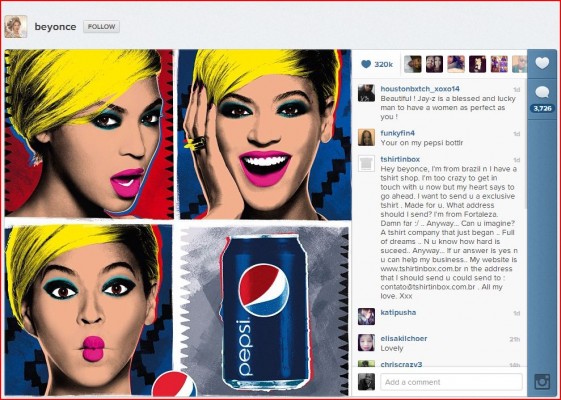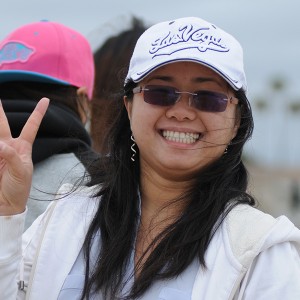
Art 110: Introduction to the Visual Arts
Summer 2014
■ Section 1: Class No.10416 – 100% Online Course
Instructor: Glenn Zucman
• [email protected]
• Office Hours: Mon 9-10am via Google Hangouts & by appointment
ART110 – VISION
In 1439 Johannes Gutenberg invented the printing press. In 1991 Tim Berners-Lee invented the World Wide Web. 40 years ago Marshall McLuhan said that our classrooms were (I’m paraphrasing a bit) too Gutenberg and not enough Berners-Lee. For Summer Session 2014, Art110 will try to be a little less Gutenberg and a little more Berners-Lee.
This course will cover 3 million years of Art History: from a proto-human moment in a distant South African cave, to the autonomous, post-human, Images That Think out somewhere in cyber-space. Along this journey we will consider the constantly evolving nature of human consciousness and how our consciousness is revealed & redefined through art.
PREREQUISITES
• None: This course requires no previous experience studying Studio Art or Art History.
OBJECTIVES
The purpose of this course is to familiarize the student with the practice, appreciation, and cultural interactions of art across the ages and across the globe. This course will survey the entire sweep of history from ancient art to the contemporary moment. Students will be introduced to the terms, principles, methods, theories and practices of art.
LEARNING OUTCOMES
Upon completion of this course, the student will be able to:
• Describe some of the styles, ideas, and issues found in the Western canon.
• Understand and articulate some of the ways that art functions vis-a-vis human culture
• Build upon their direct, introductory experiences, in Drawing, Painting, Sculpture, Photography, Animation, and Data Visualization in both Physical and Virtual worlds
• Articulate their understanding of the relationship between art and: culture, speech, creativity, expression.
• Describe the role of the artist in culture / society.
FORMAT OF COURSE
This course includes weekly:
- Short Art History talks on video
- “Artist of the Week” talks on video
- Discussions using Google Hangouts
- Weekly Activities
- 2 blog posts: 1 on the Videos & Hangout, 1 on your Activity
DUE
Each week’s posts are due by 11:59pm PDT on Sunday night.
LATE POLICY
On time posts receive up to 42 points. Posts up to 1 week late, receive up to 30 points. Posts more than 1 week late are not accepted.
For full details:
• Schedule (below)
• Activities page
TEXTBOOK
• The Internet
POINTS & GRADES
Each of our 12 summer weeks your work will be turned in through 2 blog posts on your own website.
12 weeks x 2 posts x 42 points = 1,008 points possible
A – 900 points
B – 800 points
C – 700 points
D – 600 points
F – 599 points & below
RUBRIC
Each post starts off with a perfect 42, and points are deducted from that if necessary:
1. No Photos: -4
2. Poor Post Naming: -4
3. Too short: -4
4. Not analytic enough: -4
5. No Group Discussion: -10
PHOTOS
Photos of what? It’s great to do screen captures of your Hangout. It’s nice to remind yourself of who you’ve met with, especially since we aren’t an F2F class. You can also do screen caps from the videos, or use Image Search to find images from the artists discussed, or other artists that come to your mind.
POST NAMES
What is “good” post naming? Mostly something that makes it easy for me to know what I’m looking at. If you’ve working on a larger project with your website, your posts don’t have to have these exact names, as long as it’s easy for me to identify. Here are some examples of good post names:
- Wk2 – Activity – Plaster Casting
- Wk2 – AH – Discussion
- Wk2 – Cave Art & Ana Mendieta
anything in that form makes it easy to know what I’m looking at and will be great.
ANALYTIC WRITING
3 & 4 are a little subjective. But the idea here is that one paragraph that restates the content of the videos is kind of short and not really analytic. 3-4 paragraphs each of decent length where you talk about your group discussion, perhaps about your groupmates, and definitely try to analyze the ideas, is great! By “analyze” I mean rather than restating facts, you try to make those ideas your own by seeing what truth you find in them, or alternative thoughts you have, or other artists that come to mind. Maybe this is art you’ve never even known about or thought about before… does it make sense? Does it expand your perspective on art and the practice of artists? Do you reject that this work even is art? Does it resonate with personal experiences in your own life or things you’ve seen in the world?
For the weekly Activity post you can write a bit less. It’s more about posting a couple of pix or a video that shows what you tried to acheive that week. You’re not graded on “success,” only on making a sincere effort. You can still talk a bit about whether you’ve used this media before, how your experience went: was it easy? was it fun? was it successful? do you want to try it again? what would you do different? and so on.
GROUP DISCUSSION
Discussing the week’s ideas with your peers is an essential part of the Summer Online Experience. You can document your conversation with a simple screenshot and describing a little about your conversation. Video Chat makes communicating easier and I think more fun. But if you’re having too many technical issues, text chat is ok. Try to work it out for next week.
No one is required to conquer schedule or technical difficulties. If your classmates won’t respond to emails or there are technical issues, just message Glenn and we’ll work something out. All you’re asked to do is make a sincere effort to meetup with your group. Please don’t wait till the end of the week to try to find a time. Message everyone on Monday or Tuesday.
Pretty much, if you put up 2 posts a week with Pix, Good Titles, nice Analysis, and Group Discussion, you should totally ace this class.
OTHER DETAILS
Incompletes
The Art Department grants “incompletes” rarely and only for the most extreme conditions.
Accommodation
CSULB will make reasonable accommodations for any student who has a disability. It is the student’s responsibility to notify me in advance of the need for special accommodations. This course utilizes many activities and many tools. Most of you should have no trouble with any of this, however if anyone has challenges with any course aspect for any reason, please be in touch ASAP and we can work to find suitable alternatives. A sincere effort should result in real learning and a good grade, so never be afraid to ask for any accommodations you need, but do make a sincere effort.
FUN!
Don’t forget to have fun! Art is a fun, interesting, exciting, and enjoyable subject. Art offers pleasure to the viewer, consolation to the distraught, and wisdom to the seeker. Art will enrich your leisure time, resonate with your life, and offer surprising relevance to almost any career field you choose!
SCHEDULE
Week 1
Week of May 27
Learning Objectives:
Lecture & Discussion:
Consider the 3-million-year impulse of human beings and our ancestors to make art and aesthetic experience. How art expresses who we are, our hopes and our fears, and how Allan Kaprow used the most subtle activities to explore art and life, and our human presence on this earth.
Activity:
This week we begin the ePortfolio (or “blog” or “website”) that I hope you’ll still be using long after you’ve left Art110. Not only Artists, but really all of the many different majors across the CSULB campus that take Art110 need a compelling online presence or ePortfolio in the 21st century. Whether you’re an Engineer, Scientist, Business Person, Social Scientist, Performing Artist, Communication Scientist, Journalist, Kinesiologist or Fashion Merchandiser, having your own website where you can present and control your public face is essential in the 21st century.
Week 2
Week of June 2
Learning Objectives:
Lecture & Discussion:
To think briefly about cave art and how the markings on cave walls have so much to say about who we are today. The art of Ana Mendieta.
Activity:
This week we’ll have our 3D Art, Sculpture Experience by making a Plaster Casting of your hand or foot at the beach. It’s a good excuse to go to the beach as part of your “school” this summer, but it’s also a great way to use natural resources to come pretty close to the way “real” objects are fabricated. Normally casting uses finer sand than beach sand and a hinged mold so you can get the object out more cleanly, but we’ll do a pretty good approximation at a local beach.
Week 3
Week of June 9
Learning Objectives:
Lecture & Discussion:
Brief introduction to art in Classical Greece and Rome and how it influences Western and American culture today. The art of Francesca Woodman.
Activity:
We’ve started our ePortfolio and this week we’ll do a New Media vlog to best present our portfolio to the world. This is a short, look at your audience, 1st person video where you introduce yourself.
Week 4
Week of June 16
Learning Objectives:
Lecture & Discussion:
The Middle Ages and Joseph Cornell are very different art experiences! Different as they are we may find some sort of kinship in the style and often obsessive detail found in Middle Ages architecture and illuminated manuscripts, and the elaborate “Wonder Cabinets” of Cornell.
Activity:
This week and next we’ll try out the best known forms of “Art,” the 2D media of Painting & Drawing. Our twist is that we’ll explore P&D in the context of Street Art and Urban Culture. This week you’ll try drawing your name in Bubble Letters, and next week you’ll paint it.
Week 5
Week of June 23
Learning Objectives:
Lecture & Discussion:
The Renaissance, The Baroque, and a young, 19-year-old woman who, 151-years-ago, changed the nature of the representation of women in art.
Activity:
In part 2 of our Traditional Arts Media meets Urban Culture we’ll try a little Street Art by legally spray painting our names in Bubble Letters. You can use cardboard or plywood in your back yard, or if you can make it out to the Venice Beach Legal Art Walls, you can have another beach trip and soak in a lot of culture in the remarkable high-and-low culture capital of Venice.
Week 6
Week of June 30
Learning Objectives:
Lecture & Discussion:
We’ll look at the explosion of new ideas in the 19th century and the manufacturing of identity in the photography of Nikki S. Lee.
Activity:
This week we’ll think about the new field of Relational Aesthetics: how artists create works that reflect on social relationships. We’ll think about it with an Instagram “group self-portrait”. Tuesday of this week each of us will post 4 Instagram pix (or more) of whatever we’re doing during the 24 hours of the day. Well use the hashtag #art110summer14 and then look at the 100+ pix we’ve created together to see what commonalities and differences we can find in our group life.
Week 7
Week of July 7
Learning Objectives:
Lecture & Discussion:
This week’s artist of the week, sound artist Janet Cardiff, creates sonic narratives you experience in specific sites. As Cardiff remaps urban spaces, we’ll think about our own mapping of experiences into “realist” or “romantic” spaces.
Activity:
This week’s activity is about the world of Design around us. Both hardware and software design. In Rapid Prototyping we’ll make simple, cheap, fast models of new ideas that we can “use” (or pretend use like a new phone design made out of a piece of foam) to get quick feedback on our ideas.
Week 8
Week of July 14
Learning Objectives:
Lecture & Discussion:
Two weeks ago I called the 19th century an explosion of ideas. This week we’ll look at the 20th century where we’ll find more change and new ideas than perhaps all the preceding centuries combined. We’ll also learn about “The Grandmother of Performance Art,” Marina Abramovic.
Activity:
This week we’ll think about Arts Funding. How does an artist earn a living? 5 centuries ago you might have had a wealthy patron like the Medici family. In some ways today isn’t that different, with Americans like Eli Broad or Europeans like Charles Saatchi using their fortunes to make powerful marks on our cultural rivers. In addition to the Gallery system, there are also funding organizations like the National Endowment for the Arts, and new Crowdfunding platforms like Kickstarter which launched in 2009. This week we’ll make another vlog, this one being a pitch video we might use for a Kickstarter project to pitch our ideas to friends, family, and other patrons.
Week 9
Week of July 21
Learning Objectives:
Lecture & Discussion:
This week we’ll consider 2 powerful aspects of the way we think about art: Abstraction & Representation. We’ll also visit the poster-children of New Media pranks: Eva & Franco Mattes. Their work is cheeky and silly, but also a powerful, even scathing critique of contemporary culture.
Activity:
This week we dive into Identity Art and maybe a bit of Performance Art by thinking about Counterfactual Identity. For one day you can dress up differently than you normally do and see how people react to you. What do they think your major is? What do they think your name might be?
Week 10
Week of July 28
Learning Objectives:
Lecture & Discussion:
Back in the 20th century, Copyright was relevant to very few people. If you were a rock star, a record label, or a movie studio, you wanted to control your copyrights, and you may have made a fortune doing so, but for “the rest of us” the topic was mostly irrelevant. Today almost everyone creates their own “Intellectual Property” and uses / abuses the “Intellectual Property” of others, every day. We’ll think about what freedom and creativity mean in our time, and do so by considering the sad case of Aaron Swartz who died last year.
Activity:
In Week 6 we used photography or social media photography as part of our Relational Aesthetics activity. This week we’ll do somewhat more traditional 2D Photography. We’ll still have a bit of a twist as our photo project is to imagine our own demise and then photograph it in our Landscapes with a Corpse project.
Week 11
Week of August 4
Learning Objectives:
Lecture & Discussion:
Last week we thought about Free Culture and Hacking. This week Hacking and Activism meet Art in our consideration of Hacktivism. We’ll meet the man who read the names of real dead American soldiers in the game America’s Army, and became a virtual Gandhi in cyberspace.
Activity:
In the past 10 weeks we’ve tried 10 different art media. Of course there are thousands of different media possibilities today. This week, You Pick! Pick any media you’d like to try: Yarn Bombing, Internet Hacktivism, Video, Installation, you name it!
Week 12
Week of August 11
Learning Objectives:
Lecture & Discussion:
To wrap up our “formal” Art110 class and send you off on your “informal” Art Appreciation that I hope will go with you for the rest of your life, we’ll have a little virtual party with two eccentric but enormously powerful thinkers of the 20th century: Andy Warhol & Marshall McLuhan.
Activity:
Finally, after doing 11 different art activities, it’s time to teach one! The best way to learn something is to teach it to someone else. Let’s wrap up our course experience by sharing something about art with others. You can make a video or use other media and teach any art idea or technique. You don’t have to be an expert, just communicate what you know as clearly as you can.






Leave a Reply